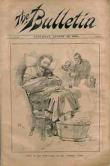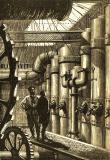AustLit
Latest Issues
AbstractHistoryArchive Description
Notes
-
Steampunk note : This story fits the category of 'proto-steampunk' in that it utilises the trope of the mechanical automaton, a common steampunk element, in a story written well before steampunk emerged as a distinct style. The story also makes use of anachronistic technology to fill a contemporary social need.
Publication Details of Only Known VersionEarliest 2 Known Versions of
Works about this Work
-
Australian Writers Have Been Envisioning AI for a Century. Here Are 5 Stories to Read as We Grapple with Rapid Change
2024
single work
column
— Appears in: The Conversation , 4 April 2024;'Australians are nervous about AI. Efforts are underway to put their minds at ease: advisory committees, consultations and regulations. But these actions have tended to be reactive instead of proactive. We need to imagine potential scenarios before they happen.' (Introduction)
-
No Stairs in the Bush? Disability and Australian Steampunk
2023
single work
criticism
— Appears in: Antipodes , vol. 36 no. 1 2023; (p. 34-48)'With a combination of fantastical and anachronistic technologies and neo-Victorian settings, steampunk emerged from a niche genre to a widespread phenomenon. But this, in turn, raised urgent questions about the "punk"-ness of steampunk and the extent to which it can critique, avoid, and repurpose the Victorian trappings that it adopts. This article examines one such query: whether steampunk can interrogate its ableist underpinnings and, particularly, whether Australian steampunk writers do so in a way that is distinctly Australian. Beginning with a brief overview of Australian steampunk and the genre's conflicted approach to disability aesthetics and roleplaying, the author examines three case studies: the invisibility of disability in late nineteenth- and early twentieth-century proto-steampunk stories, prosthetics as a vehicle for imperial trauma, and the recurrent motif of the clockwork heart. As Australian steampunk exists outside the genre's mainstream, so too is it able to speak to the marginal elements, such as underlying ableism, that the mainstream too often ignores.' (Publication abstract)
-
No Stairs in the Bush? Disability and Australian Steampunk
2023
single work
criticism
— Appears in: Antipodes , vol. 36 no. 1 2023; (p. 34-48)'With a combination of fantastical and anachronistic technologies and neo-Victorian settings, steampunk emerged from a niche genre to a widespread phenomenon. But this, in turn, raised urgent questions about the "punk"-ness of steampunk and the extent to which it can critique, avoid, and repurpose the Victorian trappings that it adopts. This article examines one such query: whether steampunk can interrogate its ableist underpinnings and, particularly, whether Australian steampunk writers do so in a way that is distinctly Australian. Beginning with a brief overview of Australian steampunk and the genre's conflicted approach to disability aesthetics and roleplaying, the author examines three case studies: the invisibility of disability in late nineteenth- and early twentieth-century proto-steampunk stories, prosthetics as a vehicle for imperial trauma, and the recurrent motif of the clockwork heart. As Australian steampunk exists outside the genre's mainstream, so too is it able to speak to the marginal elements, such as underlying ableism, that the mainstream too often ignores.' (Publication abstract)
-
Australian Writers Have Been Envisioning AI for a Century. Here Are 5 Stories to Read as We Grapple with Rapid Change
2024
single work
column
— Appears in: The Conversation , 4 April 2024;'Australians are nervous about AI. Efforts are underway to put their minds at ease: advisory committees, consultations and regulations. But these actions have tended to be reactive instead of proactive. We need to imagine potential scenarios before they happen.' (Introduction)
-
cAustralia,c





